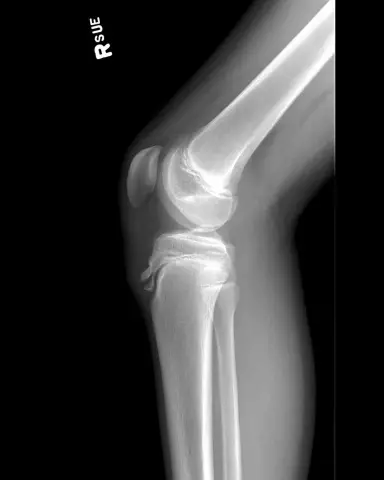- Author Rachel Wainwright [email protected].
- Public 2023-12-15 07:39.
- Last modified 2025-11-02 20:14.
Raynaud's disease
General characteristics of the disease

Raynaud's disease or Raynaud's phenomenon is one of the rare diseases of the arteries of the extremities. It manifests itself in vasospastic (spontaneous) contraction of the vessel walls. As a result of this, a bloodless area is formed in a person - ischemia. Prolonged angiospasm of the arteries leads to a change in the color of the tissues of the limb - one of the main symptoms of Raynaud's disease.
Raynaud's disease is localized, as a rule, on the feet or hands of a person. The defeat of the arteries is usually bilateral symmetrical. Risk factors that provoke Raynaud's disease include frequent cases of hypothermia (hypothermia of the lower extremities), trauma, systematic intense stress on the limbs, as well as endocrine disorders and severe emotional stress. Raynaud's disease is more likely to affect women under 40. The disease is often found in people suffering from migraines.
Raynaud's disease must be distinguished from Raynaud's syndrome. The development of angiospasm of the extremities against the background of chronic scleroderma and other pathologies of the connective tissue indicates Raynaud's syndrome. It differs from Raynaud's disease in the later manifestation of symptoms, asymmetry in the manifestation of angiospasms, and in the obligatory combined course with another vascular or autoimmune disease.
Raynaud's disease symptoms
In the development of Raynaud's disease, it is customary to distinguish 3 stages with characteristic signs of the disease. The symptoms of Raynaud's disease of the first stage is a significant increase in the tone of the walls of blood vessels. Hypertonia leads to short-term spasm of the arteries, pallor of the skin and acute pain - some more important symptoms of Raynaud's disease at this stage. After a short-term attack, the pain goes away and the color of the extremities becomes natural again.
At the second stage of Raynaud's disease, pronounced cyanosis, marbled skin color, and swelling of the extremities join the symptoms of the first stage. This stage of the disease is also accompanied by intense pain during the attack. The first two stages of Raynaud's disease can develop up to 3-5 years.
A symptom of Raynaud's disease of the third stage is the appearance of areas of necrotic tissue on the limbs. Due to violations of the blood supply to the extremities, wounds on them do not heal well. At this time, the addition of a secondary infection is possible, as well as the development of sepsis.
Diagnosis of Raynaud's disease
Diagnosis of Raynaud's disease involves assessing the following criteria:
- the level of circulatory disorders in the limbs,
- symmetry of areas with angiospasms,
- the presence of other phlebological diseases,
- duration of manifestation of symptoms of Raynaud's disease at least 2 years.
During the diagnosis of Raynaud's disease, capillaroscopy of the patient's nail bed is performed. It allows you to visualize and study functional and structural changes in the arteries of the extremities.
Another stage in the diagnosis of Raynaud's disease is cold tests to assess the condition of the limbs after they are immersed in water with a temperature of 10 ° C for 2-3 minutes.
Differential diagnosis of Raynaud's disease involves the exclusion of about 70 autoimmune and phlebological diseases that may be accompanied by Raynaud's syndrome.
Raynaud's disease treatment

When diagnosed with Raynaud's syndrome, the main efforts are directed to the treatment of the underlying disease. Treatment of Raynaud's disease takes place in a different direction, namely in the relief of symptoms of the disease and prevention of the causes that cause attacks of the disease.
In the first stage of Raynaud's disease, treatment is extremely conservative. An attack of angiospasm is easily removed with the help of warm baths, wrapping, massage of the diseased part of the limb. Medication for Raynaud's disease is to take vasodilators. The patient is advised to exclude the possibility of hypothermia, limb injuries and, if possible, not worry.
At the stage of ulceration and tissue necrosis, the patient is prescribed local wound healing therapy. Drug treatment of Raynaud's disease can last for several years, up to the period when attacks of angiospasm of the extremities become insensitive to vasodilator drugs.
In this case, the surgical treatment of Raynaud's disease - sympathectomy is recommended. It consists in removing or arresting the nerve fibers of the sympathetic trunk that cause spasms of the arteries. Endoscopic sympathectomy is considered the least traumatic type of surgical treatment for Raynaud's disease. During it, a clip is placed on the sympathetic trunk in the chest or neck area for the patient under general anesthesia.
An auxiliary method of treatment for Raynaud's disease is plasmapheresis sessions to remove all harmful toxic and metabolic components from the patient's blood.
YouTube video related to the article:
The information is generalized and provided for informational purposes only. At the first sign of illness, see your doctor. Self-medication is hazardous to health!






